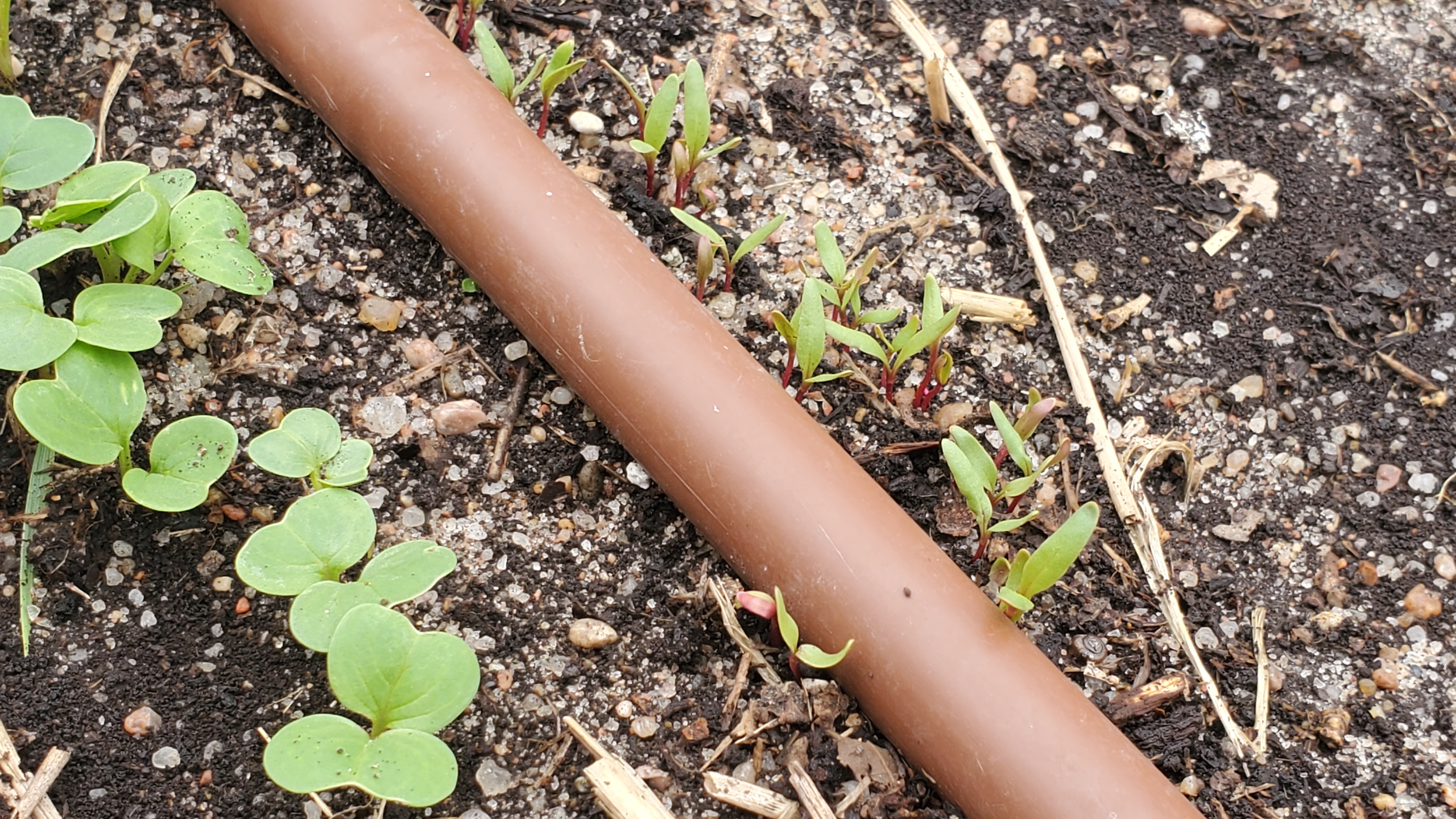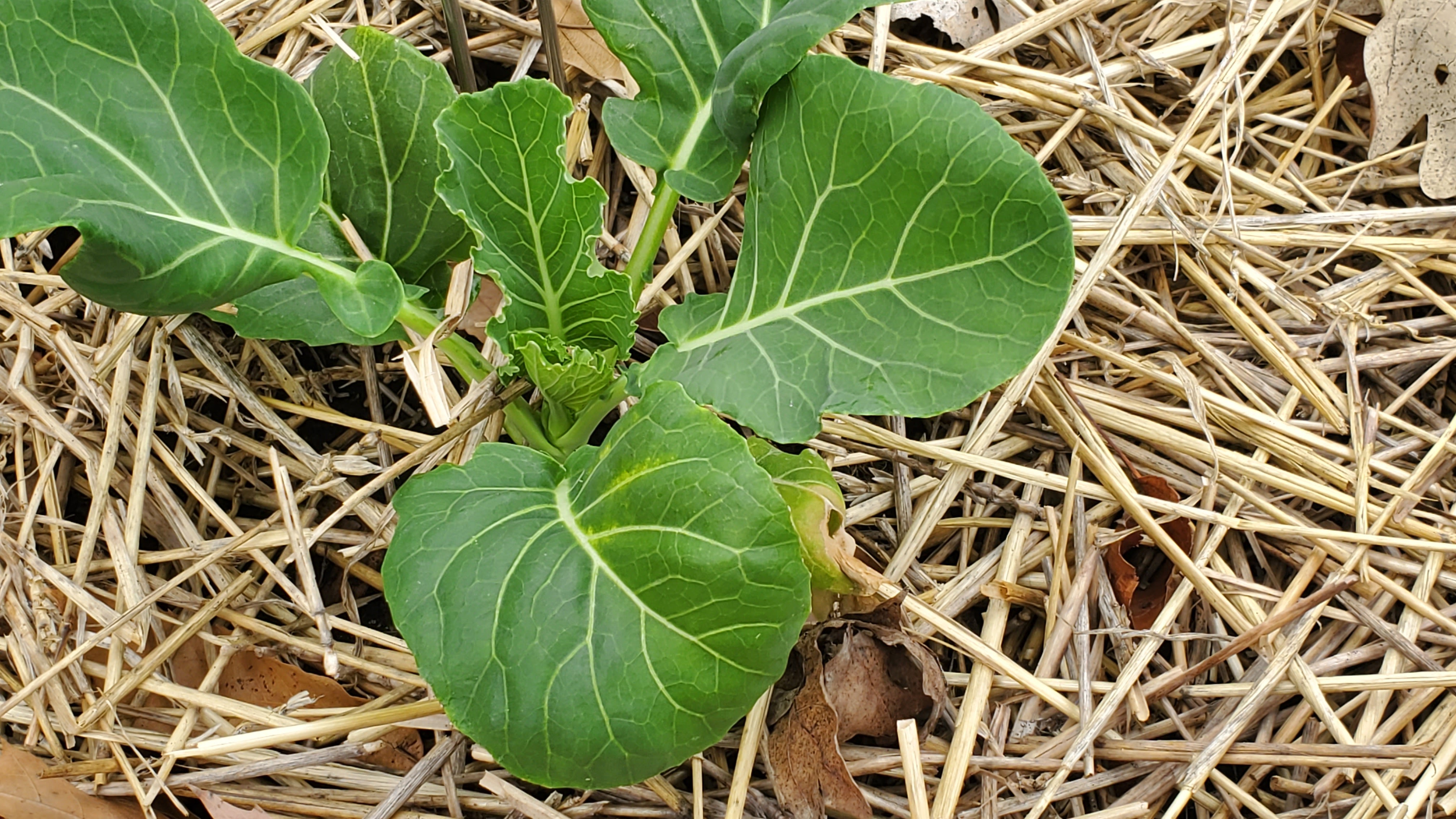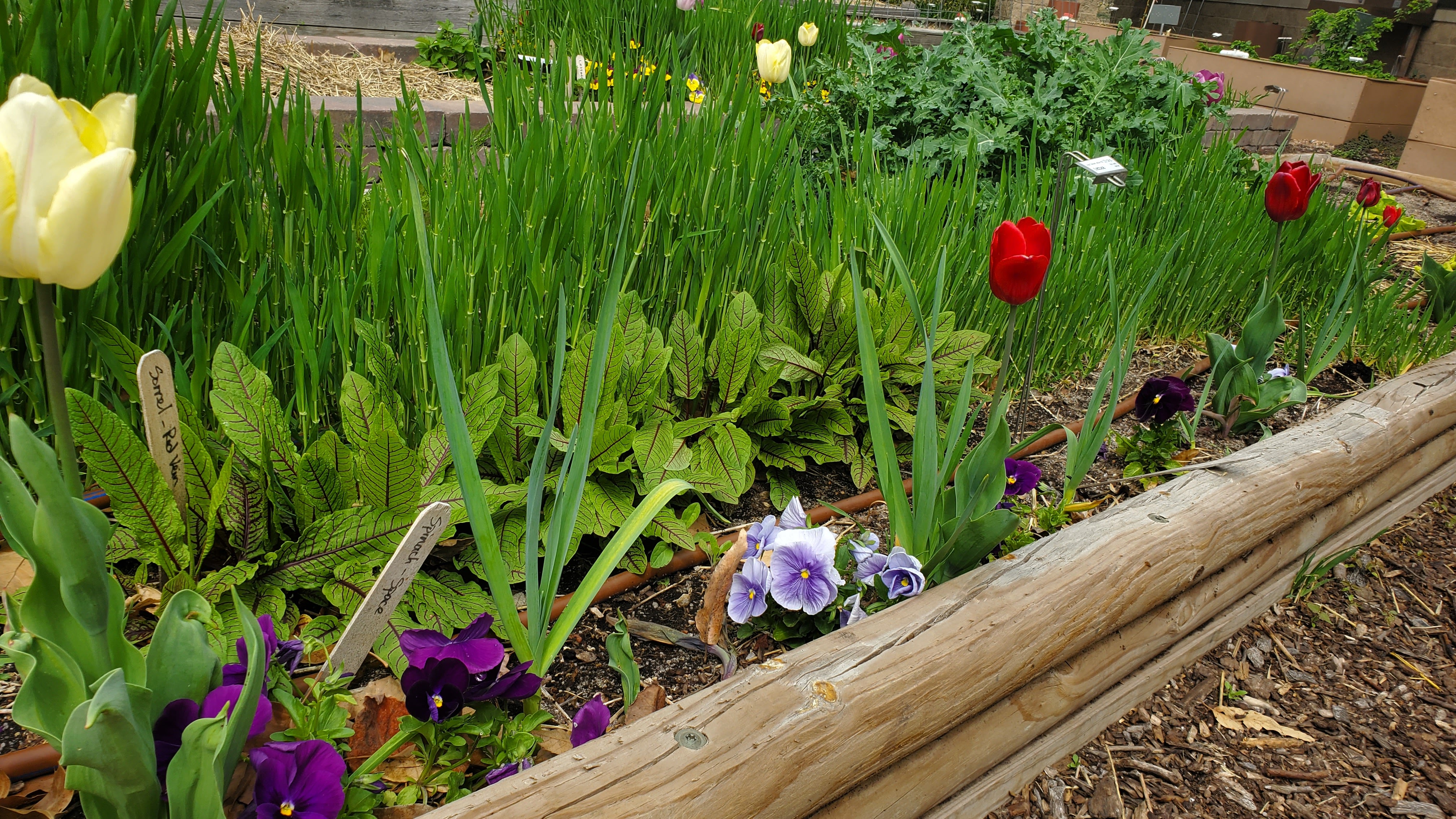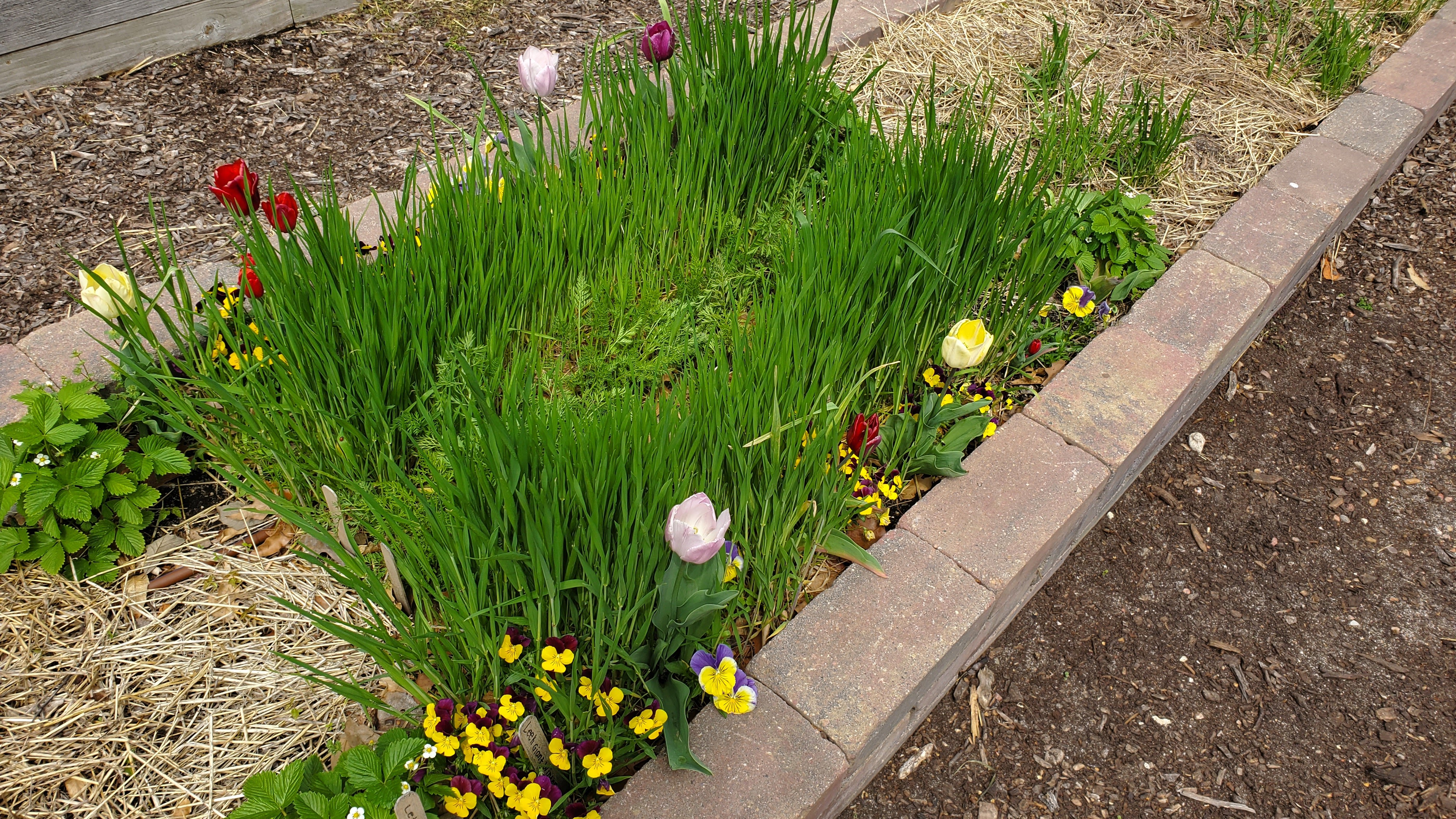Blog Archives
A Closer Look: Bed 2 Plans
Today let’s take a closer look at the plans for our second bed in the Demo Garden. This bed is fairly simple, compared to Bed 1. Half the bed is planted to tomatoes (and basil!), while the other half will be planted to potatoes in the spring and leafy greens in the fall.

I know that you are probably really excited to know more about the tomatoes – but in the interest of having something to talk about when we get to Bed 5…I’m going to make you wait. Sorry!
So that leaves us with the potatoes and the leafy greens. Bed 2 is our only raised bed that did NOT show nematode damage last season, so it is both our “control” bed for our tomato varieties so we can compare productivity and growth with Bed 5, which has heavier nematode infestation. We also chose to plant potatoes in this bed, since they can have nematode issues as well. One of our Master Gardener plants red, white, and blue potatoes with their grandchildren, so we thought that would be a fun approach.
In the half of the bed with potatoes, we divided the space into three 4’x4′ areas, with each area for a different variety. Our red variety is ‘AmaRosa’ Fingerling. I know the map has three things listed – we weren’t sure what we would be able to find, so I had a list to look for. But I found this one, which was our first choice. ‘AmaRosa’ is a fingerling potato (so longer and slender), with red or burgundy skin and marbled pink and white flesh. Yep, interior flesh is pink and white! We actually just planted the potatoes this morning, and I was pleasantly surprised by how large the seed potatoes were, so that bodes well for a healthy crop.
Our white variety is ‘Kennebec,’ which is a long-time, high yielding basic white potato. It is a midseason variety, and has a good package of disease resistance. This is a common variety that you can probably easily find in a local garden center.
Our blue variety is a newer variety (although it has been around for several years at this point), called ‘Adirondack Blue.’ It is one of the darker blue/purple fleshed potatoes that you can find, and the color holds well, especially if you roast it. The plants themselves are also supposed to have a slight blue color to the leaves.
Once the potatoes are harvested in the summer, we will likely plant a buckwheat or sunn hemp cover crop in that area while waiting for cool weather to return for our fall planting. If you aren’t familiar with sunn hemp, it is a summer annual legume that grows quickly, fixes nitrogen, and suppresses root knot nematodes.
For our leafy greens, ‘Astro’ Arugula is probably the most common, reliable variety. ‘Black Magic’ is a newer cultivar of the traditional Lacinato/dinosaur kale that was selected for uniform, long, slender leaves. ‘Joi Choi’ Bok Choy is a larger choy variety, 12-15″ tall at maturity, with thick bright white stems. ‘Kookaburra’ spinach is a fast-growing semi-savoy variety that is supposed to perform well in the fall. It is fairly upright, which is nice in our gardens because the sandy soil can get on the lower leaves when it is rainy.
Check back next week to hear about Bed 3!
2022 Demo Garden Plans
Our garden plans for this year are both a return to a greater diversity of plants and the start of a multi-year effort to combat the increasing levels of root knot nematode that we have been experiencing in our beds. With the exception of Bed 2, all of the plants we removed or harvest last fall had some amount of root knot nematode damage, so we will be doing a wide range of things to work to improve that. (For more information on what root knot nematodes are, go here: https://hnr.k-state.edu/extension/info-center/common-pest-problems/common-pest-problem-new/Nematodes.pdf)

As you can see from the list on the right, we have quite a range of different things planned for the garden, including some things we haven’t done in many years and others that are brand new to us! We haven’t had a large area dedicated to culinary and tea herbs for many years. the herbs have mostly been in containers and smaller beds since we renovated the garden in 2012, so having the entirety of Bed 1 dedicated to herbs is a change for us.
You will also notice that we have “N-Resistant tomatoes” in both Beds 2 and 5. This means that we have chosen nematode resistant cultivars for our planting plans, with the exception of one variety that is our “control” variety as a comparison. In Bed 6, we have plans for a lettuce quilt (more below), and will be doing some soil solarization and cover crops after the spring harvest is complete in hopes of significantly reducing the nematode populations in that bed.

We have gone all out in filling our herb bed with a plethora of diversity! Very roughly, the green end are more culinary herbs (with some crossovers) and the red end is more tea herbs (again with some crossovers/dual purpose plants). The blue center is pretty much a mixture. Because the blue center sections of the bed had really terrible nematodes last year, we will be planting the majority of the plants will be in large containers, except for the marigolds, oregano, marjoram, salad burnet, and nasturtiums which are “supposed” to have some resistance to the nematodes.

Bed 2 was the only bed that didn’t have nematodes visible on the plant roots when we cleaned up the garden last fall. Whether that was because of the hot peppers populating most of the bed or other factors, it is hard to say. But with that in mind, we are using half of the bed as our “control” for our nematode resistant tomato cultivars. We chose 5 cultivars that are known to have resistance to nematodes, and one variety, ‘Chef’s Choice Orange,’ that is not identified as having nematode resistance, but that we have grown successfully here in the past. We will have the same cultivars planted in Bed 5, which had very high levels of nematodes last year so that we can compare the performance of the varieties in each bed. In the other half of the bed we will have red, white, and blue potato varieties in the spring and some cool season leafy greens in the fall.

In Bed 3, we have chosen a “Latin America” theme. We have jalapeno, Guajillo, anaheim, and chile de arbol peppers, all common in Latin America. We will have three different varieties of tomatillos: one green, one purple, and one sweet yellow. Tomatillos produce best when there are at least two different varieties for pollination. We chose two paste tomatoes (nematode resistant!) for this garden, as well as two Mexican/Latin American herbs: epazote and papalo. On the left end of the bed, we will have a round Mexican squash that is supposed to be resistant to squash vine borer, as well as Chayote squash. We aren’t sure that the Chayote will produce this far north, but you have to try things, right? Under the trellis we will be growing a whole bunch of cilantro in the spring and then let it flower and go to seed for coriander in the summer.
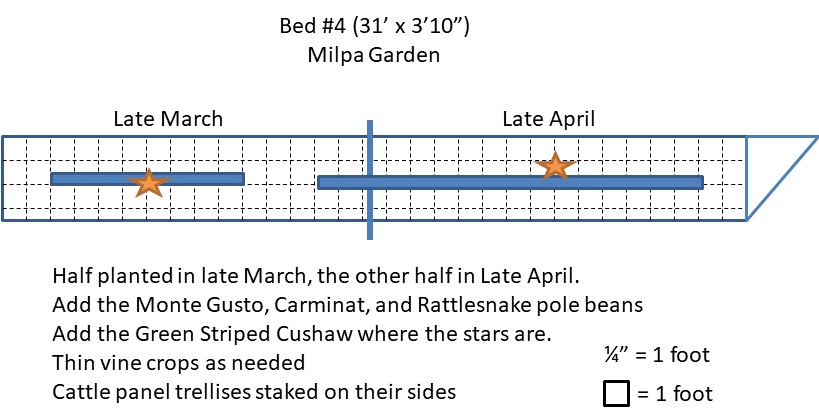
In yet another big change from past tradition, we are going to be planting the Milpa Cover Crop mix from Green Cover Seed as a partnership with our Sedgwick County Soil Conservation District. Not content to leave it alone, we are going to try it at two different planting times, and then add some additional pole beans and a green striped cushaw squash in the center of each half, with some of our trellises providing additional support. The mix isn’t really at its best in a raised bed situation, so we are going to have to judiciously thin out plants as we go to make sure that it isn’t a complete mess of things that will get into the walkways and such. That is also why we are adding in the trellises – just to give the vines a bit more room to roam vertically.

Bed 5 is the other half of our nematode resistant tomato variety demonstration, so the same things as in Bed 2. As you may have noticed, we are also trying out lots of the Emerald Towers and Thai Towers basils – new cultivars that are highly resistant to downy mildew and that are also much later to bolt (flower and seed) than other basils. We really want to see how they perform here!

Bed 6 is a little bit of a throwback to something we did several years ago – a quilt block lettuce garden. We are doing a basic nine-patch pattern with lettuce transplants on one end, plain rows of some root vegetables in the middle, and then a direct-seeded star pattern of lettuce and Brassica leafy greens on the other end. Once the spring crops are harvested, this bed will be covered with plastic for soil solarization, as this is our worst bed for nematodes. After several weeks of solarization, we will end the year with a cover crop that is also nematode-resistant/non-host.

In our accessible garden areas, in the tiered raised bed we will be reprising some cucumbers and melons that we attempted in 2020 but that didn’t quite get a fair trial with full attention.

Finally, in our salad table, we will have some mustard greens, radishes, and lettuce planted for the spring. The small barrel planter will continue to house our chives for another season. Not pictured is our new-last-year Tower Garden, which will have a mixture of leafy greens, herbs, flowers, vegetables, etc. I went through my old seeds to find some goodies, and with 53 planting holes to fill, we should have lots of options!
If all goes well, you should check back soon for more updates and details – although it didn’t happen last year. If nothing else, be sure to come out and visit the garden in person!
2021 Demo Garden Plans and Updates
Our Demo Garden plantings are well underway for this year, and we already have some exciting things to showcase. But first – here’s a quick overview of what we are planning to grow this year!

We chose to continue to focus our garden efforts on productivity and yield over diversity for this year. We are planning to continue donating our harvests to the Common Ground Producers & Growers Mobile Market for their Seniors First food box program, which provides free food boxes to low income seniors.
With that in mind, we are keeping each garden bed to only a couple different types of produce, although we still have more diversity of varieties than you might otherwise see. We are also focusing on interplanting and succession planting to use our space well. For example, in bed 1, we have radishes planted between rows of beets and carrots and IN the row with the parsnips to use every square inch of space. In Bed 2, we are filling the space with lettuce and spinach now, and then the peppers for the remainder of the season will be planted into the leafy greens while they finish their spring season. In Beds 4 and 5, we have planted broccoli, cauliflower, and peas under the trellises that will hold the cucumbers and squash later in the summer to get an additional crop out of those spaces.
The Master Gardeners have been hard at work getting the garden into shape for the spring, and almost all the beds have either seeds or transplants already growing. We had covered most of the beds with straw last fall, so that is both good and bad now – the soil stays moist with the straw, but we have lots of wheat seedlings growing. We also needed to move quite a bit of the straw around to facilitate seed planting.
The other thing I’m excited to show off a little bit are a couple of the school garden templates that I developed last year and planted last fall.
The templates are 4×8 layouts designed with high diversity (and relatively low productivity) for better interest and learning experiences in a school garden setting. (You can see all the templates and supporting information here: Kansas School Garden Guide.) Both of the templates shown here were designed to be planted last fall and overwintered. These overwintered with NO additional protection from the elements. They include pansies, tulips, garlic, shallots, alpine strawberries, barley or wheat, and vegetables (kale, carrots, red-veined sorrel, spinach).
If you haven’t been out in awhile, our garden is always open to the public – best viewed during daylight hours! Things will be changing fast as it gets warmer, so don’t miss out on the opportunity to visit.
Purple Sprouting Broccoli
Broccoli is one of those vegetables that can be a little bit “hit or miss” in Kansas, especially in the spring. The cool parts of the growing season, spring and fall both, can sometimes be too short and too erratic to have great broccoli. Over the years we have tried several kinds of broccoli, some that performed well and others not so much.
This year, we chose to plant ‘Burgundy,’ a variety of purple sprouting broccoli. Sprouting broccoli is selected for high quality, uniform, and prolific side shoots. Many older “heading type” broccoli varieties would produce some side shoots, newer varieties not as much. Sprouting broccoli is designed to have the center “head” shoot pinched out at a small size to encourage more side shoots.
 We started these plants from seed in mid-February and transplanted them into the garden on March 17th. They are supposed to take about 37 days from transplant to maturity…but the weather was definitely not helpful on that front this year. About a week ago, the plants were showing the development of the center shoot. (About 60 days after transplanting – thanks, cold snaps!)
We started these plants from seed in mid-February and transplanted them into the garden on March 17th. They are supposed to take about 37 days from transplant to maturity…but the weather was definitely not helpful on that front this year. About a week ago, the plants were showing the development of the center shoot. (About 60 days after transplanting – thanks, cold snaps!)
 I snipped out the center stalk, and you can already see the side shoots starting to grow.
I snipped out the center stalk, and you can already see the side shoots starting to grow.
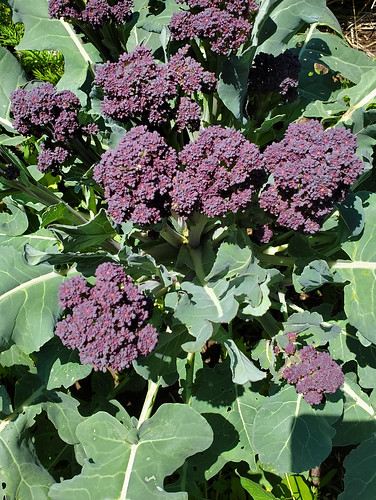 This is what the shoots are looking like now. I love the purple color! So often with purple vegetables, the color is disappointing, but this is beautiful. It is important to note that the color will fade to a beautiful dark green once it is cooked.
This is what the shoots are looking like now. I love the purple color! So often with purple vegetables, the color is disappointing, but this is beautiful. It is important to note that the color will fade to a beautiful dark green once it is cooked.
From a flavor standpoint, this broccoli is strong. The little bit that I have nibbled on, it has a very strong mustard flavor. Most homegrown broccoli is that way, and once it is cooked, it has great flavor – but it is not the mild and water flavor you maybe have come to expect from even fresh grocery store broccoli.
The idea with the side shoots is that they should continue to develop and be produced until it gets too hot, potentially having a higher yield for a single plant than with a heading type.
If you wanted to give this plant a try (and you can find the seeds available!), you should start the seeds indoors in mid- to late June, then transplant outside in late July. With some luck and decent weather, you should have some awesome broccoli sometime in September!
Updated Garden Plans!
 It has been quite the ride since I posted our first look at garden plans for this year, hasn’t it? So many things have changed, and likely many others will before it is all said and done. Because our face-to-face programming is suspended for the time being, we have been thinking about how to adjust our garden for the summer to accommodate the safety of our staff, volunteers, and the public. At the same time, we know that many new gardeners are seeking information on how to start and maintain a successful vegetable garden, and that access to fresh, healthy food is more important now than ever. (And it has always been important!)
It has been quite the ride since I posted our first look at garden plans for this year, hasn’t it? So many things have changed, and likely many others will before it is all said and done. Because our face-to-face programming is suspended for the time being, we have been thinking about how to adjust our garden for the summer to accommodate the safety of our staff, volunteers, and the public. At the same time, we know that many new gardeners are seeking information on how to start and maintain a successful vegetable garden, and that access to fresh, healthy food is more important now than ever. (And it has always been important!)
Because most of our early spring planting was eliminated, with the exception of plants that we already had ready to go, we have re-planned chunks of the garden to change those plans. We also had several parts of the garden that were planned to be more novelties, ornamental, or trials of things that we didn’t know quite how they were going to perform. In order to best fulfill our educational mission and serve our broader community, we have eliminated the majority of those types of plantings from the garden, and will instead replace them with the following:
- Extra tomato and pepper plants that we had started already.
- Beans, squash, and other common, generally productive vegetables that we had available.
- Additional plantings of varieties we have grown in the past, had leftover seed in stock, and knew were going to be productive to replace trial varieties that were less likely to perform well.
Some of the things that we have maintained include:
- Planting the square beds (8, 9, and 10) to perennial fruit plants. If you look at the pic above, you can see the dwarf apple in the front and the blackberries and raspberries growing in bed 9.
- Vertical gardening / trellises to grow lots of cucumbers, melons, and other things throughout the garden.
- The tomato trials of recent All America Selections winners.
- Lots of different colors of veggies!
An additional change, along with planting varieties that emphasize productivity, is that we will be donating significantly more of the produce to those in need. Most years, a large portion of our produce is used for educational programming – for our Master Gardeners or others in the community, and extra produce has been donated. This year the primary focus of our garden will be to donate to those in need as a food bank garden.
As always, we look forward to growing and learning along with you! You might also be interested in joining our new, Victory Garden 101 Facebook Group to engage in more conversations and learning about vegetable gardening. What changes have you made to your garden plans due to the pandemic?


